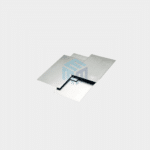Ceramics and refractory metals find important applications in sputtering processes due to their unique properties. These materials are used as sputtering targets and play a crucial role in depositing thin films with specific characteristics for various applications. Here are some of the key applications of ceramics and refractory metals in sputtering:
Applications of Ceramics:
Ceramics play a vital role across many industries due to their unique properties like high heat resistance, durability, and chemical stability. Understanding their diverse applications can help you select the right ceramic material for your needs:
- Dielectric Films: Ceramic materials like aluminum oxide (Al2O3) and silicon dioxide (SiO2) are used as sputtering targets to deposit dielectric thin films. These dielectric films are used in microelectronics for insulating layers, capacitor dielectrics, and passivation layers.
- Ferroelectric Thin Films: Lead zirconate titanate (PZT), a ferroelectric ceramic, is used as a sputtering target to deposit ferroelectric thin films in applications such as piezoelectric devices, non-volatile memory, and sensors.
- Piezoelectric Devices: Ceramics like lead zirconate titanate (PZT) and lead magnesium niobate-lead titanate (PMN-PT) are used as sputtering targets to produce piezoelectric thin films for applications in ultrasound transducers, sensors, and actuators.
- High-K Dielectrics: High-k dielectric materials, such as hafnium oxide (HfO2) and zirconium oxide (ZrO2), are sputtered onto semiconductor substrates to create gate dielectrics in advanced CMOS devices, improving their performance.
Read also: what are the advantages and applications of sputtering techniques?
Application of Refractory Metals:
Refractory metals are prized for their exceptional heat resistance and strength at high temperatures. These properties make them essential in industries where materials must perform reliably under extreme conditions. Here are the application of refractory metals:
- Barrier Layers: Refractory metals like tungsten (W) and molybdenum (Mo) are used as sputtering targets to deposit thin films as barrier layers in microelectronics. They prevent interdiffusion between different materials in the semiconductor device, improving device reliability.
- Copper Diffusion Barrier: As copper is used in advanced semiconductor interconnects, refractory metals like tantalum (Ta) and tantalum nitride (TaN) are sputtered to create a barrier layer between the copper and the dielectric material to prevent copper diffusion.
- Interconnects: Tungsten (W) is used as a sputtering target to create conductive lines and vias in microelectronics, ensuring low resistance and high melting point, which are essential for miniaturized devices.
- Metal Gates: Refractory metals like hafnium (Hf) and zirconium (Zr) are used as sputtering targets for depositing metal gate electrodes in advanced CMOS transistors.
- Wear-Resistant Coatings: Refractory metals like titanium (Ti) and tantalum (Ta) are used as sputtering targets to create wear-resistant coatings on cutting tools, bearings, and other mechanical components.
- Optical Coatings: Refractory metals, such as tantalum (Ta) and chromium (Cr), can be used as sputtering targets to produce optical coatings for mirrors, beam splitters, and other optical components.
Read also: How to select between various Refractory Metals?
Both ceramics and refractory metals are chosen as sputtering targets based on their unique electrical, mechanical, and thermal properties, making them suitable for a wide range of applications in microelectronics, optics, materials science, and other industries. These materials enable the deposition of thin films with specific properties, contributing to the development of advanced technologies.
Conclusion:
In conclusion, ceramics and refractory metals play a vital role in sputtering processes due to their outstanding thermal stability, chemical resistance, and durability. Their unique properties ensure consistent performance and longevity of sputtering targets and components, making them indispensable in producing high-quality thin films for electronics, optics, and various advanced industrial applications. Choosing the right materials helps optimize efficiency and product quality in sputtering systems.
We are a USA company catering products and solutions in the USA, Australia, New Zealand, Singapore, Malaysia, India, South Korea and Vietnam.






